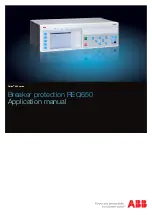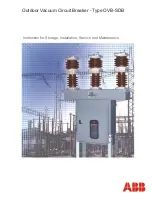
MB556
User
Manual ◄ 13
Breaker tool bit binding
Figure 9. Breaker Tool Bit Binding
Do not pry with bit and breaker. The tool bit may
break causing injury.
Excessive side force cocks the tool in its bore, prevents
proper movement and causes premature tool shank and
bushing wear. Since the breaker tool bit must be pushed
up into the breaker to operate, a binding tool prevents
the breaker from operating correctly. Binding also causes
the tool bit and tool bushings to seize and often results
in breakage of one or more breaker components.
Always direct the down pressure force in a line toward
the point of tool contact with the work.
Moving rocks with the tool bit is another method of
binding the tool bit. This practice should be avoided as it
may cause tool bit failure.
Rebar reinforced concrete introduces the problem of
concrete chunks being held together by the rebar after
the concrete has been broken. The best approach to
this problem is to use a chisel point tool which permits
cutting the rebar with the breaker. Another method is to
periodically cut the rebar with an oxy-acetylene torch
BLANK FIRING
To understand “Blank Firing”, the operator needs to be
aware that the tool bit is able to drop down in the lower
body cavity, far enough so that the piston cannot strike it,
when the tool bit is not in contact with the work surface.
“Blank Firing” occurs whenever the breaker is operating
and the piston is not able to strike the tool bit solidly or not
strike the tool bit at all. “Blank Firing” accelerates wear
and tear on breaker and carrier components and may
result in failure of one or more components. Excessive
“Blank Firing” may be considered equipment abuse and
may result in voiding warranties.
Break-through or difficult surface contact results in
“Blank Firing” when the material being broken fractures
and the tool bit is no longer in “hard contact” with the
material but is still pushed high enough in the lower body
cavity so that the piston can strike it. In this position,
the piston strikes the tool bit and the tool bit, in turn,
is driven against the retaining pins because it is not in
sufficient contact with the material to be broken. The
energy is absorbed by the retaining pins, other breaker
components, and the carrier boom components. “Blank
Firing” of this type can be experienced in trench work
where obtaining striking contact with the work surface is
difficult or the wrong tool bit is used, or in flat rock work
where the operator fails to stop operation of the breaker
when slippage, fracturing or material break-through
occurs.
“Blank Firing” as a result of operator error occurs when
the tool bit is not in contact with the work surface to be
broken and is allowed to drop down in the lower body
cavity so that the piston is not able to strike it. Instead, the
downward movement of the piston will be stopped by an
internal oil cushion located at the bottom of the piston’s
stroke and the energy of the piston will be absorbed by
breaker components and excavator boom components.
“Blank Firing” of this type can be experienced when the
operator fails to stop operation of the breaker when the
material fractures or material break-through occurs, or
during re-positioning of the breaker.
While “Blank Firing” cannot always be avoided, it can be
kept to a minimum by avoiding the above conditions as
much as possible.
UNDERWATER USAGE
Underwater usage of the breaker will cause damage
to internal components. Even if the breaker is partially
submerged, water is introduced to an area between
the tool bit and piston. On the piston down cycle, the
water becomes compressed and damages adjacent
components.
OPERATION
Summary of Contents for MB556
Page 28: ...28 MB556 User Manual MB556 POWER CELL ILLUSTRATION ...
Page 29: ...MB556 User Manual 29 HOUSING PARTS ILLUSTRATION ...
Page 33: ......
Page 34: ......
Page 35: ......








































